You might not know Sedona’s red rocks glow more at sunrise than at sunset, revealing hidden spires and soft slot canyons few visitors see. You’ll find iconic hikes like Cathedral Rock and Devil’s Bridge, secret creekside pools, art‑filled patios, and off‑road Pink Jeep thrills that change how you see the desert. Stay for a morning stargaze or a quiet vortex meditation — and you’ll soon want a plan for every glowing trail.
Hike Cathedral Rock
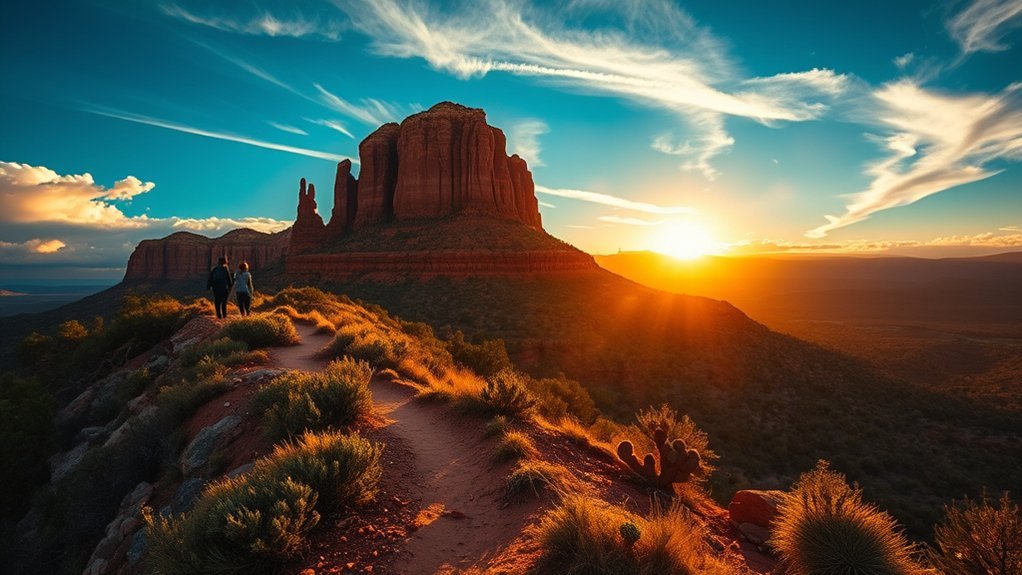
Climb Cathedral Rock for one of Sedona’s most iconic views — a steep, short hike that rewards you with sweeping red-rock panoramas and a feeling of being on top of the world. You’ll start on well-marked trails that rise quickly; expect rocky steps and uneven footing, so wear sturdy shoes and watch each step. The climb is under an hour for fit hikers, longer if you pause to photograph narrow spires and dramatic light. Bring water, sun protection, and a light layer — winds pick up near the saddle. Once you reach the saddle, you’ll find multiple ledges offering distinct perspectives: look south toward the valley, west to layered sandstone, and up close at striated rock faces carved by time. The site can be busy at sunrise and late afternoon, so arrive early for solitude or golden light. Respect trail etiquette, pack out trash, and leave the fragile vegetation undisturbed to keep Cathedral Rock pristine.
Walk Devil’s Bridge Trail
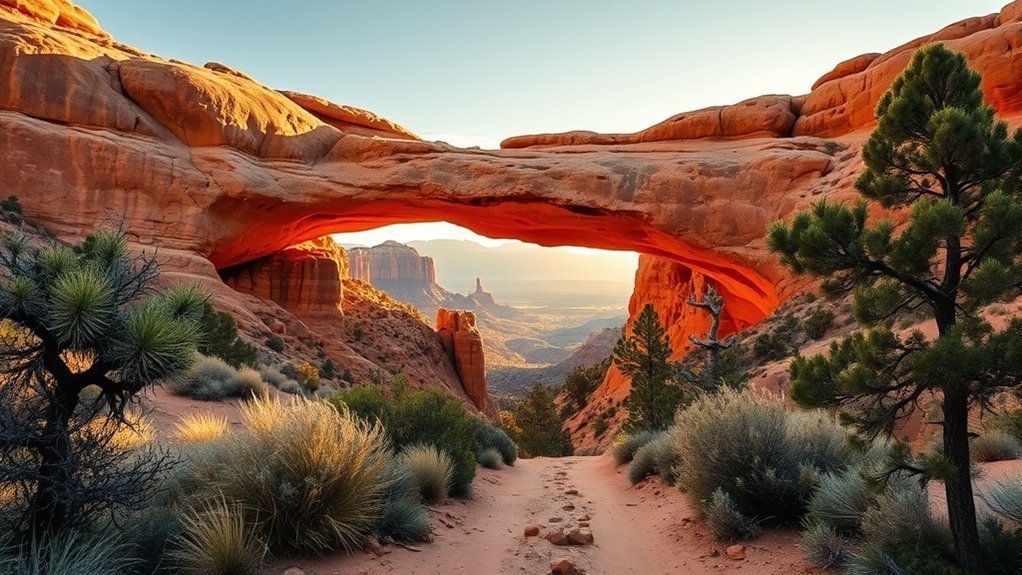
Set out early to walk Devil’s Bridge Trail and you’ll be rewarded with one of Sedona’s most dramatic natural arches — a short, moderately steep hike that culminates in a narrow sandstone bridge you can step across for sweeping canyon views. You’ll feel the rock’s warm texture underfoot and the canyon air open as you climb; the final approach is exposed but manageable, and the payoff is a photo-worthy perch with real scale. Bring sturdy shoes, water, and a lightweight jacket—the trail can be windy and temperatures change quickly. Expect other hikers near the bridge; patience and timing get you solo shots.
Set out early on Devil’s Bridge Trail for a short, steep climb to a narrow sandstone perch and unforgettable canyon views
- Start at first light to avoid crowds and harsh midday sun.
- Pack 1–2 liters of water, sunscreen, and a hat for protection.
- Keep to single-file on the bridge and respect others’ photos and space.
Move deliberately, respect the landscape, and the view will feel earned and unforgettable.
Explore Bell Rock Pathway
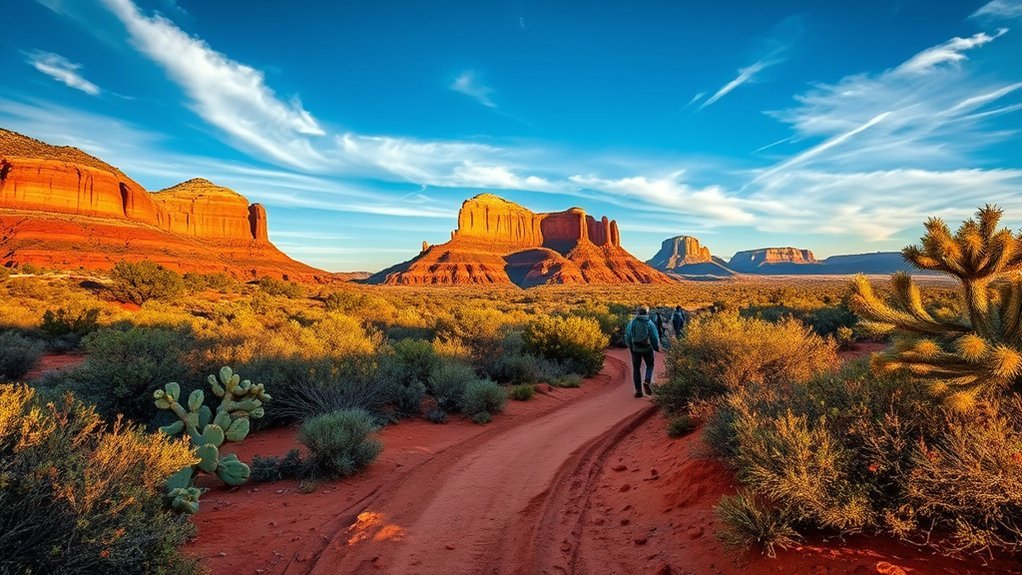
Head up the well-marked Bell Rock Pathway and you’ll find a family-friendly loop that rewards easy effort with iconic red-rock panoramas and sweeping views of Cathedral Rock and Courthouse Butte. You can choose a short, flat loop for a relaxed stroll or extend your outing by climbing the gentle slopes toward Bell Rock’s base for closer textures and layered vistas. The trail’s sandy footing and clear signage make navigation simple; bring sturdy shoes and sun protection since shade is scarce. Along the way, you’ll notice sculpted sandstone, native shrubs, and occasional juniper—great markers for photographers and casual naturalists alike. If you’re timing matters, sunrise and late afternoon cast the richest colors and reduce midday heat. Dogs on leash are welcome, and a nearby parking area and restrooms keep logistics straightforward. Whether you’ve got kids, a camera, or just a few spare hours, Bell Rock gives reliable scenery and an accessible taste of Sedona’s red-rock magic.
Visit Oak Creek Canyon
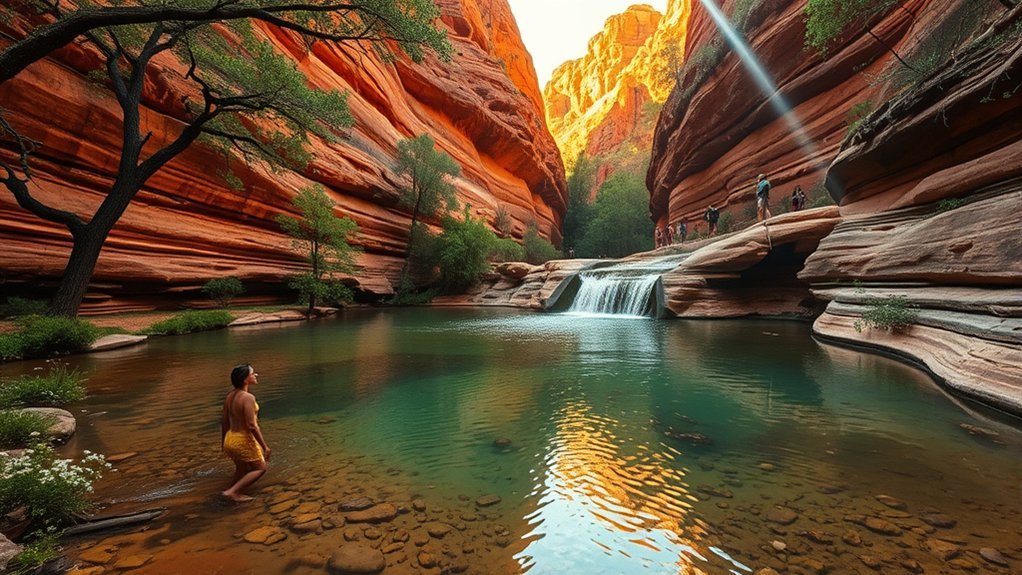
Winding between towering red walls and shaded sycamores, Oak Creek Canyon offers a cool, scenic escape from Sedona’s sun-baked vistas where you can hike riverside paths, picnic beside clear pools, or dip your toes in riffles that sparkle with trout. You’ll feel the temperature drop as the canyon narrows, hear water over stones, and find quiet spots that invite slow breathing and clear thinking. Paths range from easy strolls to steeper trails that reward you with viewpoints and secluded swimming holes. Bring sturdy shoes, a refillable bottle, and a light layer—the shade can hide slick rocks and sudden chill. Respect posted signs and private land; the creek’s health depends on mindful visitors.
- Choose a short trail (West Fork for shade) and start early to avoid crowds.
- Pack a small picnic and leave no trace.
- Carry a map, water, and sun protection even in canopy areas.
Drive Red Rock Scenic Byway
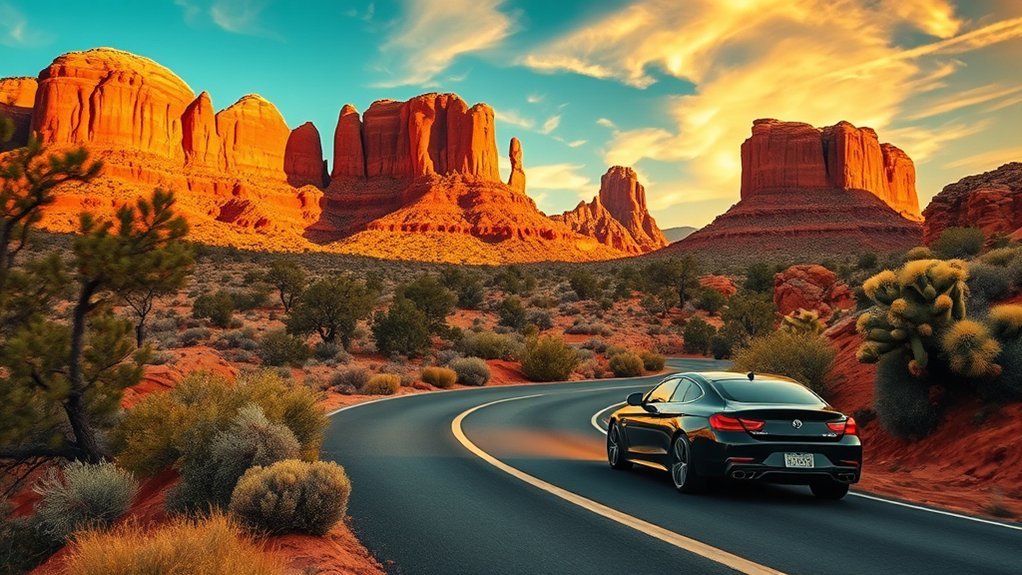
Take Red Rock Scenic Byway at a relaxed pace and you’ll be rewarded with sweeping viewpoints and easy pullouts perfect for photos. Aim for early morning or late afternoon light to avoid crowds and catch the red rock glow. Along the route you’ll find short hikes and charming stops—think Chapel of the Holy Cross, Bell Rock trailheads, and picnic-ready pullouts.
Scenic Viewpoints & Pullouts
As you drive the Red Rock Scenic Byway, every pullout feels like a carefully framed photograph — jagged red spires, sandstone fins, and cottonwood-dotted washes unfold at short intervals so you can stop, step out, and drink it in. You’ll find viewpoints that suit a ten-minute stretch or a quiet half-hour. Park safely, use marked paths, and let the vistas orient you to landmarks like Cathedral Rock and Bell Rock. Binoculars and a camera do wonders; shade and water keep you comfortable.
- Pick a pullout for a short stroll to a ledge — quick payoff, minimal effort.
- Choose a scenic turnout at sunset for deep color and long shadows.
- Stop where interpretive signs explain geology and ecosystem.
Best Times to Drive
When you time your drive right, the Red Rock Scenic Byway feels like a living slideshow—soft morning light brings out warm layers in the sandstone, midday highlights details for photos, and evenings drench the cliffs in deep reds and golds. Aim for early morning to beat traffic and catch calm, cool air; parking is easier and shadows sculpt the formations. Midday works if you want crisp, shadow-free shots and clearer views, though it’s busier and hotter in summer. Golden hour before sunset delivers the richest color and a quieter road as tour buses thin out. On weekends expect more cars; consider weekdays or shoulder seasons (spring, fall) for milder temperatures and clearer skies. Pack water and plan stops.
Nearby Stops & Hikes
While you’re cruising the Red Rock Scenic Byway, pull over at its easy-access stops to stretch your legs and plunge into short hikes that reward you with iconic views—Bell Rock’s base trail offers sweeping vistas in under an hour, Cathedral Rock gives dramatic photo opportunities (steeper and rockier), and the Chapel of the Holy Cross provides a quick, paved viewpoint with interpretive signs. You’ll find each stop close enough to the road for flexible timing, but distinct in mood and terrain. Pick one based on how much climbing you want, then use the list below to refine your visit and leave time to savor the scenery.
- Choose Bell Rock for gentle walking and panoramic outlooks.
- Choose Cathedral Rock for sunset photos and scrambling.
- Choose Chapel of the Holy Cross for architecture and easy access.
Take a Pink Jeep Tour
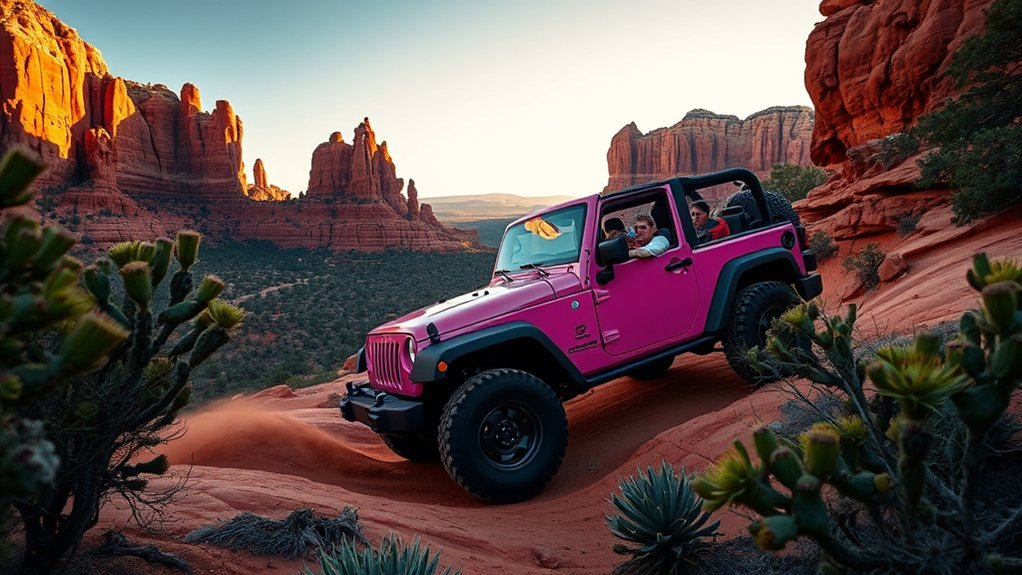
Hop into a Pink Jeep and feel the thrill as your guide takes you off-road across dramatic red rock formations. You’ll stop at carefully chosen viewpoints for sweeping photos and expert tips on lighting and composition. The guided tour keeps you safe while making sure you don’t miss the best scenic moments.
Off‑Road Red Rock Adventure
Climb into a Pink Jeep and you’ll feel the red rock landscape come alive as the driver maneuvers over slickrock, tight ledges, and dramatic drop-offs—this isn’t just a scenic ride, it’s an up‑close off‑road adventure guided by experts who know Sedona’s geology, history, and best photo angles. You’ll bounce along sandy washes, crest ridgelines, and peer into hidden canyons while your guide explains rock formations, native plants, and local lore. Wear closed shoes, bring water, and secure loose items. Expect thrilling inclines and brief hikes to overlook points where the scale of the landscape hits you.
- Book morning or late afternoon for cooler temperatures.
- Tell the guide about mobility concerns.
- Carry a small daypack with essentials.
Guided Scenic Photo Stops
Settle into a Pink Jeep and let an expert guide steer you to the picture-perfect overlooks where light, shadow, and Sedona’s red rocks line up for unforgettable photos. You’ll stop at curated vantage points—each chosen for composition, color, and changing light—so you can focus on framing rather than finding the route. Guides share local history, geology, and timing tips to help you capture sunrise warmth, midday contrast, or golden-hour glow. They’ll suggest lenses, exposure settings, and stable footing, and they’ll point out hidden angles most visitors miss. Tours range from short photo-focused outings to extended excursions that combine sunsets and stargazing. Bring a tripod, spare batteries, and curiosity; the guide handles logistics so you get the shot.
Watch Sunrise at Airport Mesa
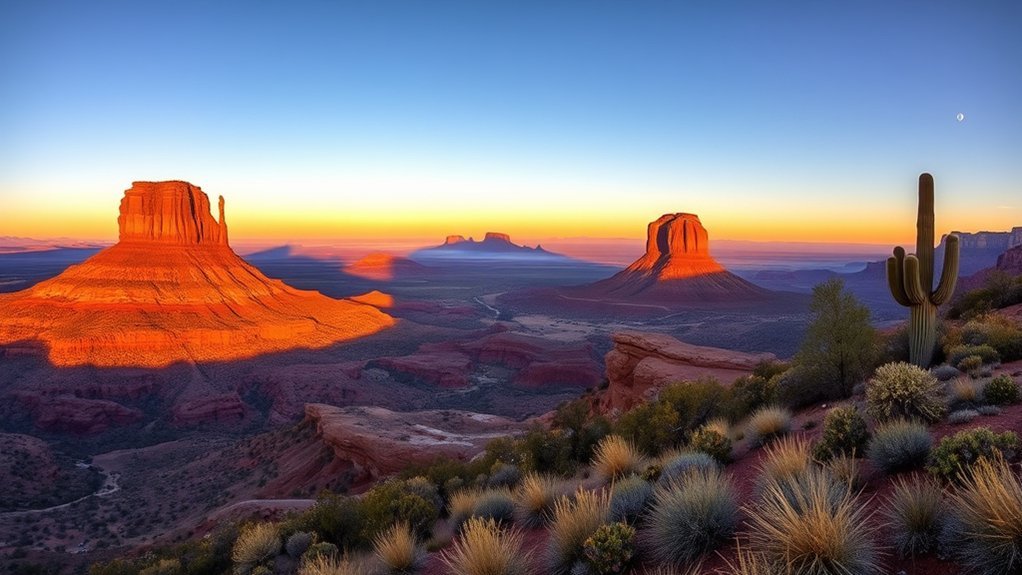
Arrive early at Airport Mesa to watch the sky change from deep indigo to blazing orange as the sun clears Sedona’s red-rock horizon. You’ll find a small, easy overlook where the light sculpts spires and washes mesas in gold. Bring a light jacket—the desert cools fast—and a camera or phone with spare battery; the colors shift within minutes. Parking fills quickly, so plan arrival 30–45 minutes before sunrise to claim a spot and settle in. Respect other visitors: keep voices low and pets leashed.
- Bring: headlamp, blanket, tripod for steady shots.
- Time: check sunrise time, arrive early, stay 20–30 minutes after first light.
- Etiquette: leave no trace, avoid trampling vegetation, follow posted signs.
You’ll leave feeling grounded and inspired, having watched Sedona wake. The experience is short but potent, offering perspective you can carry through the day.
Hike West Fork Trail
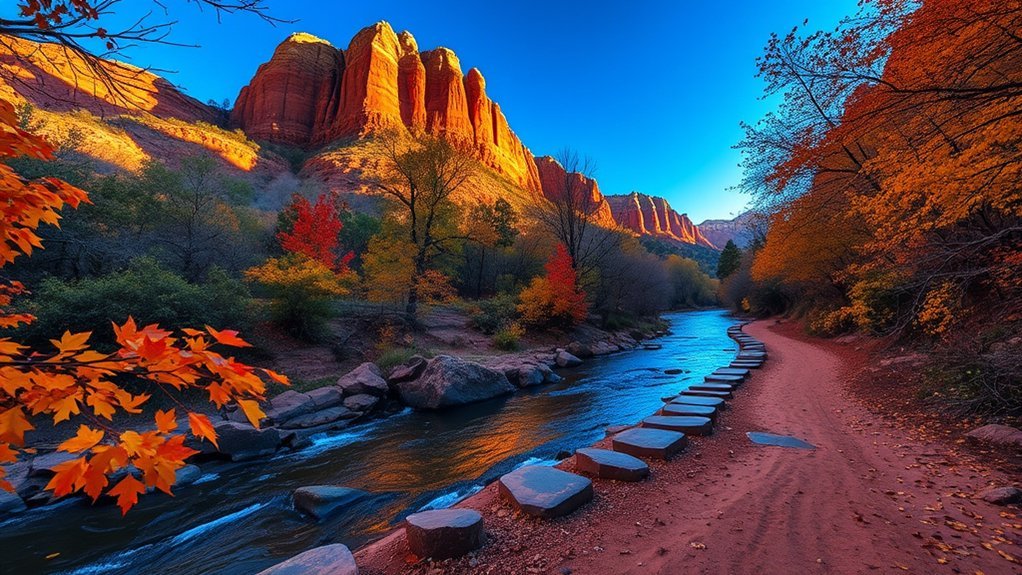
Along the cool, shaded canyon of Oak Creek, the West Fork Trail leads you through towering red-rock walls, knee-deep crossings, and a lush ribbon of cottonwoods and ferns—it’s one of Sedona’s most intimate hikes. You’ll follow a clear, well-marked path that wanders beside and across the creek; expect multiple shallow crossings where waterproof shoes or quick-dry socks make the walk easier. The trail’s moderate grade and soft footing keep the pace relaxed, so you can watch light paint canyon walls and listen to water and birds. Bring a map or use a reliable app—cell signal can fade—and carry water, sun protection for exposed stretches, and layered clothes for changing temperatures. Photography is rewarding at golden hour, but arriving early avoids crowds. If you’ve limited time, turn back at any scenic bend; the trail is linear, so plan your mileage. Respect private land, pack out trash, and leave the riparian plants intact for future hikers.
Discover Slide Rock State Park
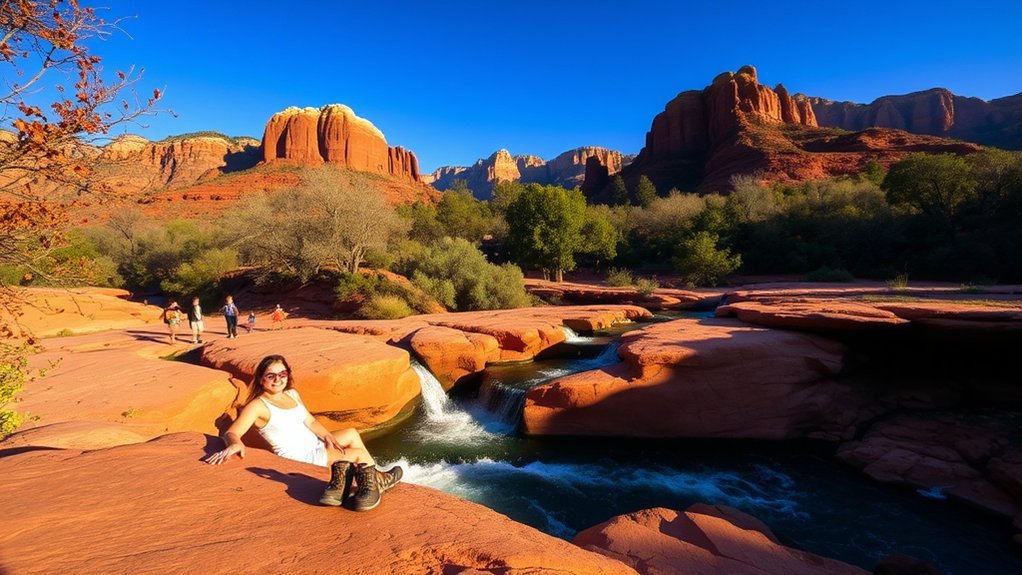
Slip into the cool canyon waters of Slide Rock State Park and you’ll find a natural waterslide carved into Oak Creek’s red sandstone—a playful, sun-drenched spot where families and hikers come to swim, picnic, and cliff-hop. You’ll feel the slick rock underfoot as the creek funnels into shallow pools framed by cottonwoods and towering cliffs. Swim with care; currents shift and the rock can be smooth. Pack a sturdy pair of water shoes, a towel, and reef-safe sunscreen. There’s a small fee and parking fills fast, so arrive early or later in the afternoon when crowds thin.
- Reserve shade: bring a canopy or pick a shaded picnic spot near the creek.
- Respect the ecosystem: carry out trash, keep noise low, and avoid trampling vegetation.
- Safety first: scout slide paths before you go, watch children closely, and know your limits.
Slide Rock rewards you with vivid scenery and simple, invigorating fun you’ll remember.
Tour Chapel of the Holy Cross
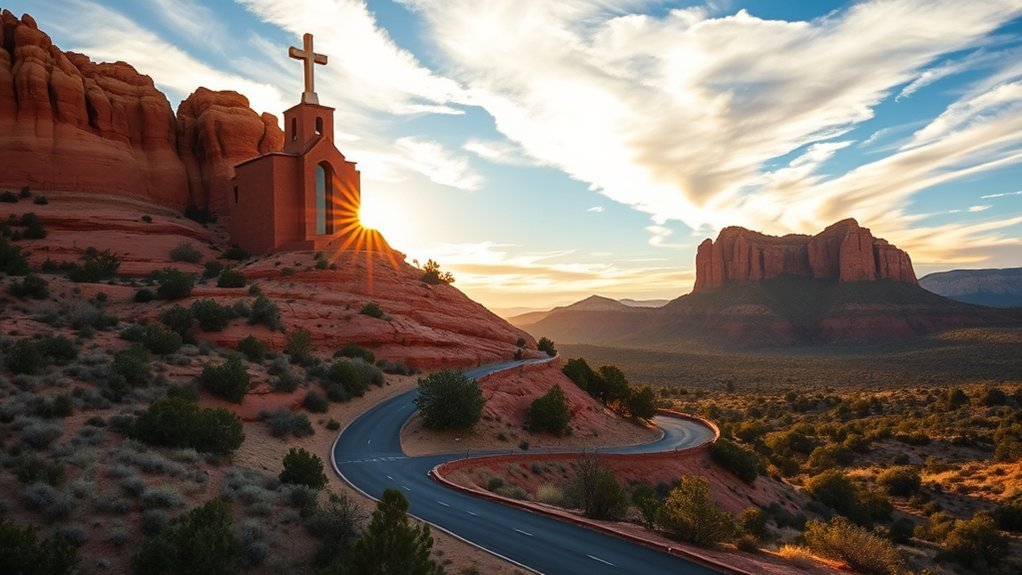
Perched dramatically against a red-rock buttress, the Chapel of the Holy Cross invites you to pause and take in one of Sedona’s most iconic spiritual landmarks; its simple, modern lines and soaring cross feel both intimate and monumental. You’ll approach via a short drive and a modest walk from the parking area, then step inside to experience light pouring through expansive glass that frames panoramic canyon views. The chapel, completed in 1956 and designed to complement the landscape, offers quiet reflection rather than formal tours — volunteers can answer questions about its history, architecture, and spiritual role in the community. Photography is welcome; respectful behavior is expected during services. Outside, viewpoints and benches let you linger while absorbing the geology and silence. Accessibility is limited in spots, so check current conditions if mobility is a concern. Visiting the chapel grounds gives you a clear, contemplative connection to Sedona’s dramatic scenery and cultural heritage.
Browse Tlaquepaque Arts & Crafts Village
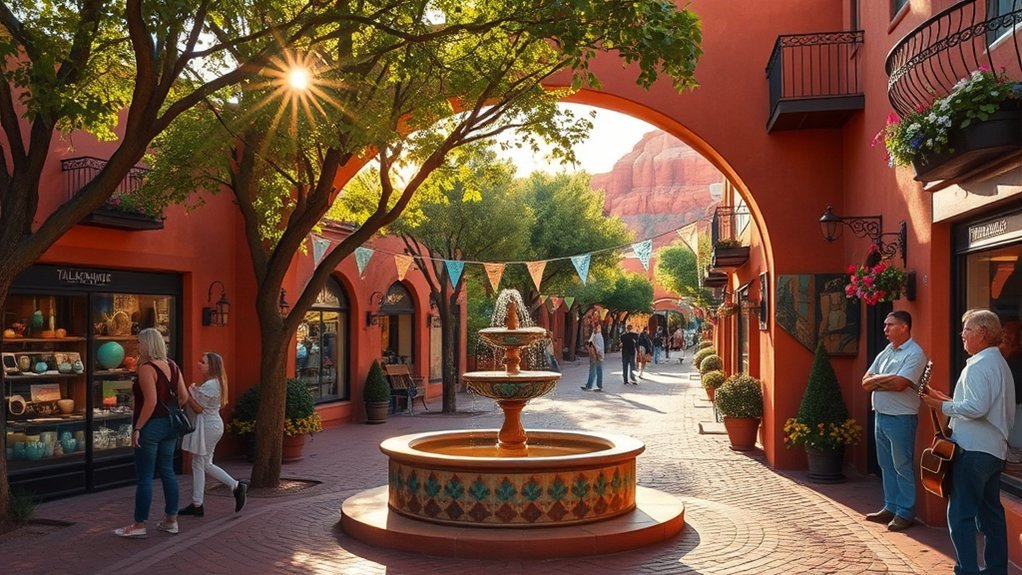
Step into Tlaquepaque Arts & Crafts Village and you’ll feel like you’ve wandered into a charming Mexican plaza tucked into Sedona’s red-rock backdrop. You’ll stroll shaded courtyards, find galleries showcasing local and international art, and hear water features that steady your pace. The architecture and winding paths make browsing an experience, not just shopping.
- Visit galleries: seek original paintings, Southwestern jewelry, and blown glass—chat with artists to learn techniques and provenance.
- Dine al fresco: choose a patio café or a refined restaurant; flavors often reflect regional ingredients and a relaxed pace.
- Shop thoughtfully: look for handcrafted ceramics, textiles, and unique gifts; many shops offer custom commissions or artist-signed pieces.
You’ll appreciate the village’s calm energy and attention to craft. It’s easy to lose track of time here, but you’ll leave with meaningful souvenirs and a clear sense of Sedona’s creative spirit.
Explore Boynton Canyon
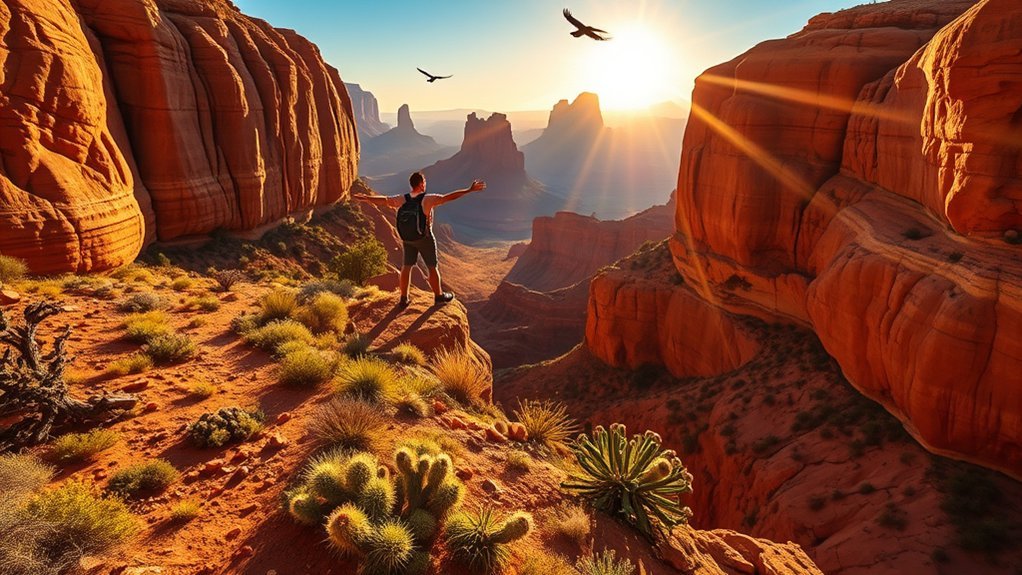
Exploring Boynton Canyon brings you into a quieter side of Sedona, where towering red-rock walls frame juniper-dotted trails and pockets of pine cool the air; you’ll find sweeping vistas, secluded alcoves, and a sense of scale that’s both humbling and restorative. You’ll follow a well-marked trail that winds through varied terrain—open slickrock, shaded riparian stretches, and classic red-rock viewpoints—so wear sturdy shoes and bring water. Look for interpretive signs that explain local geology and native plants; they help you read the landscape. Mid-hike, pause at the canyon’s amphitheater-like viewpoint to watch changing light across ridgelines or spot wildlife like canyon wrens and mule deer. If you want a longer route, connect to side trails that offer solitude and different perspectives. Respect private property and stay on designated paths to protect fragile soils and desert vegetation. Finish with a slow, mindful descent; Boynton leaves you grounded, refreshed, and tuned to Sedona’s quieter rhythms.
Experience a Vortex Site
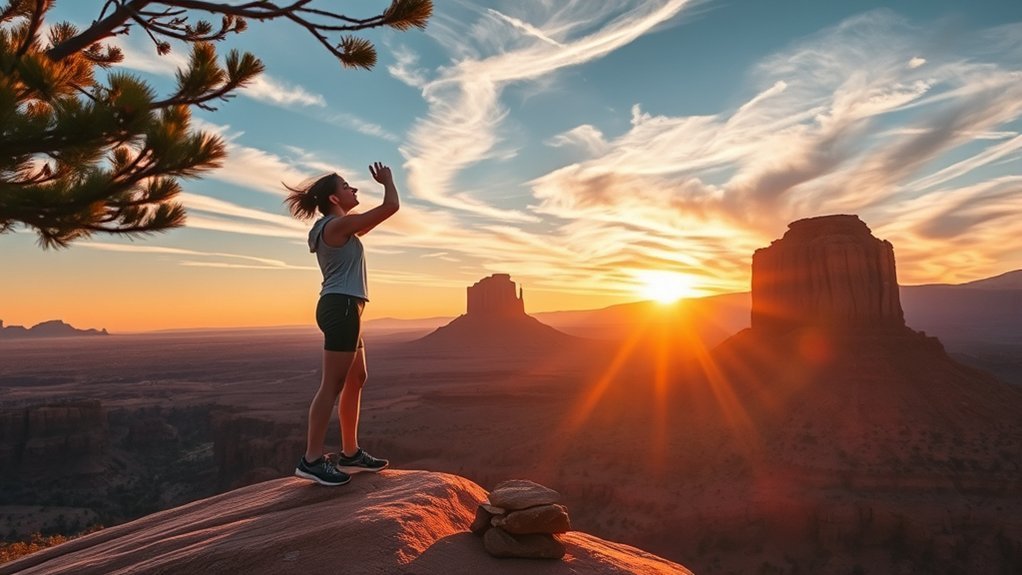
When you arrive at one of Sedona’s famous vortex sites, you’ll likely notice a subtle shift in the way the air feels and the landscape holds your attention—people describe it as a heightened calm or energized focus, depending on where you stand. You’ll want to move slowly, breathe deliberately, and let the red rocks frame your awareness. Vortexes are as much about perception as place; some visitors sit, meditate, or journal while others hike to vantage points for quiet reflection.
Arrive quietly, breathe deeply, and let Sedona’s red rocks sharpen your calm and focus.
- Walk in silence for ten minutes to orient your senses.
- Sit facing the view, close your eyes, and count slow breaths to ten.
- Note any changes in emotion, thought clarity, or body sensations—record them.
Respect trails and private land, avoid loud groups, and bring water. Whether you seek spiritual recharge or a fresh mental reset, a vortex visit offers a memorable, grounded experience.
Stroll Uptown Sedona
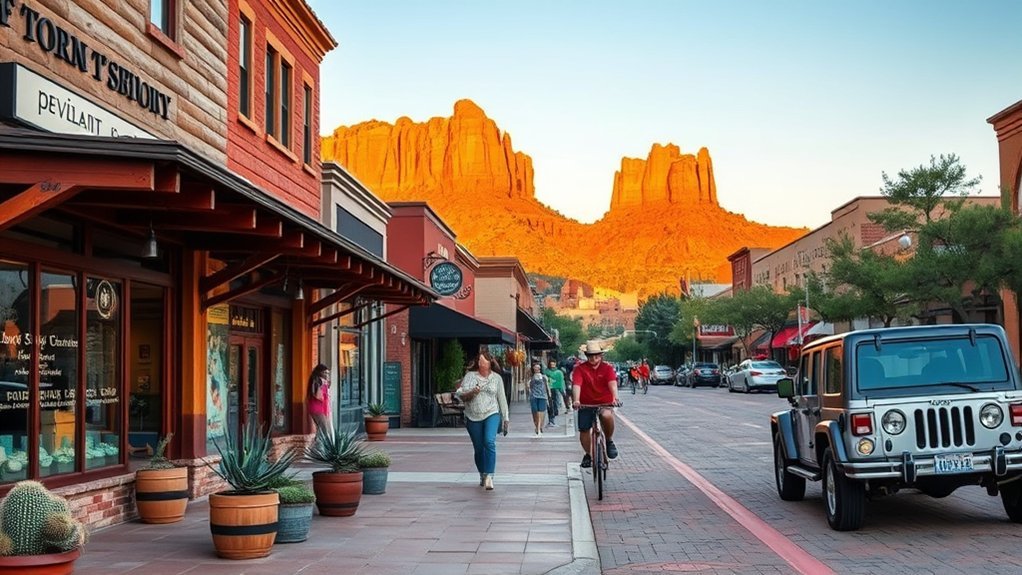
Wander through Uptown Sedona and you’ll feel the town’s pulse shift from desert quiet to lively charm, with red-rock views framing boutiques, galleries, and cafés along winding sidewalks. You’ll want to start with a slow walk down the main drag, popping into artisan shops for turquoise, handblown glass, and local jewelry—each window hints at Sedona’s creative spirit. Stop for coffee on a patio and watch hikers and families pass; the people-watching is as good as the views. Galleries showcase regional painters and sculptors; staff are usually happy to explain techniques or local inspirations. Look for tasting rooms and casual eateries serving Southwest flavors—menus often highlight local ingredients. Parking’s limited during peak times, so consider arriving early or using a shuttle. Keep your camera ready: Chapel Rock and Cathedral silhouettes make dramatic backdrops. You’ll leave Uptown feeling oriented—entertained, supplied with unique finds, and ready to explore more of Sedona’s landscapes.
Visit Sedona Heritage Museum
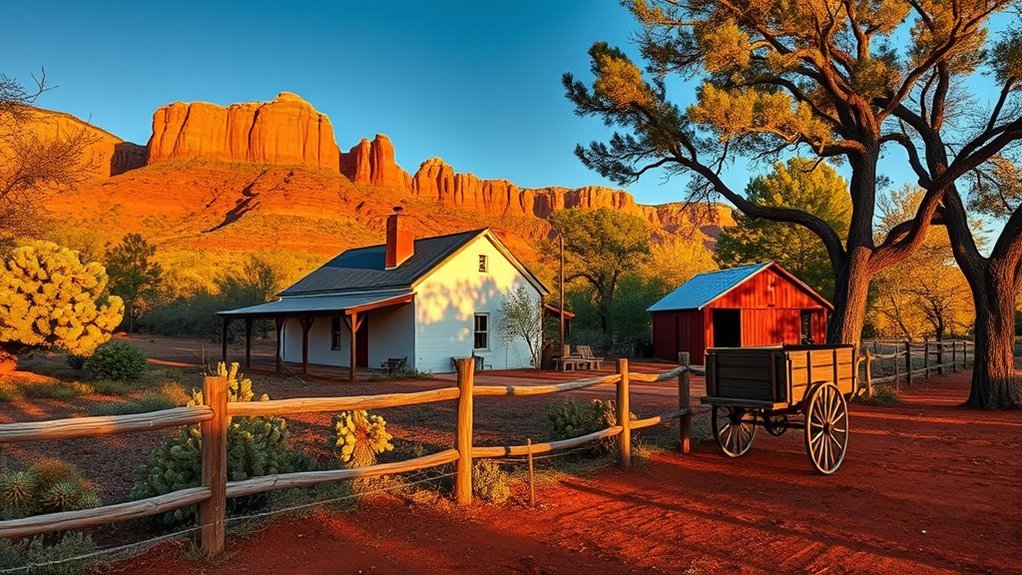
Though tucked just off the main tourist routes, the Sedona Heritage Museum invites you into the town’s real story—its ranching roots, early artists, and the movie crews that once used these red rocks as a backdrop. You’ll walk through restored buildings, see artifacts from the Schnebly family and elk ranching era, and view photos and film clips that make Sedona’s past feel immediate. The museum is compact but rich; docents answer questions and point out details you might otherwise miss. Before you go, plan to:
- Arrive early to browse exhibits without crowds.
- Join a short guided talk to hear insider stories and filming anecdotes.
- Spend time on the restored barn grounds for quiet views and interpretive panels.
The museum rewards a slow pace: you’ll leave with a clearer sense of how Sedona evolved—from homesteads and artists’ cabins to the community you explore today.
Hike Soldier Pass Trail
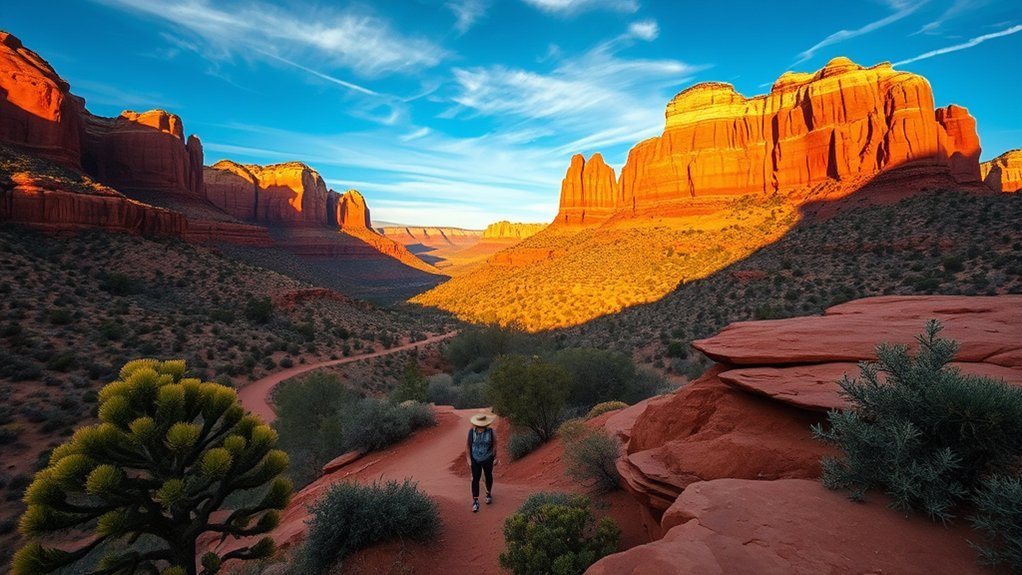
If you head out early on Soldier Pass Trail, you’ll find a hike that mixes classic red-rock scenery with surprising features—steep switchbacks, shaded juniper pockets, the Soldier Pass Sinkhole, and the iconic Seven Sacred Pools—so plan for varied terrain and photo stops. You’ll follow a well-marked path that climbs and narrows, rewarding steady steps with sweeping views of Cathedral and surrounding mesas. Bring water, a hat, sturdy shoes, and layers; shade appears and disappears quickly. Watch your footing on loose rock and respect trail signs around the sinkhole—it’s deeper than it looks. The Seven Sacred Pools collect seasonal runoff, creating reflective pockets that make excellent compositions at golden hour. Wildlife is subtle: lizards, songbirds, and occasional mule deer. You can loop back toward Soldier Pass Road or continue to Soldier Pass Trailhead for a longer outing. By pacing yourself and leaving no trace, you’ll enjoy a compact, varied hike that feels both adventurous and distinctly Sedona.
Visit Amitabha Stupa & Peace Park
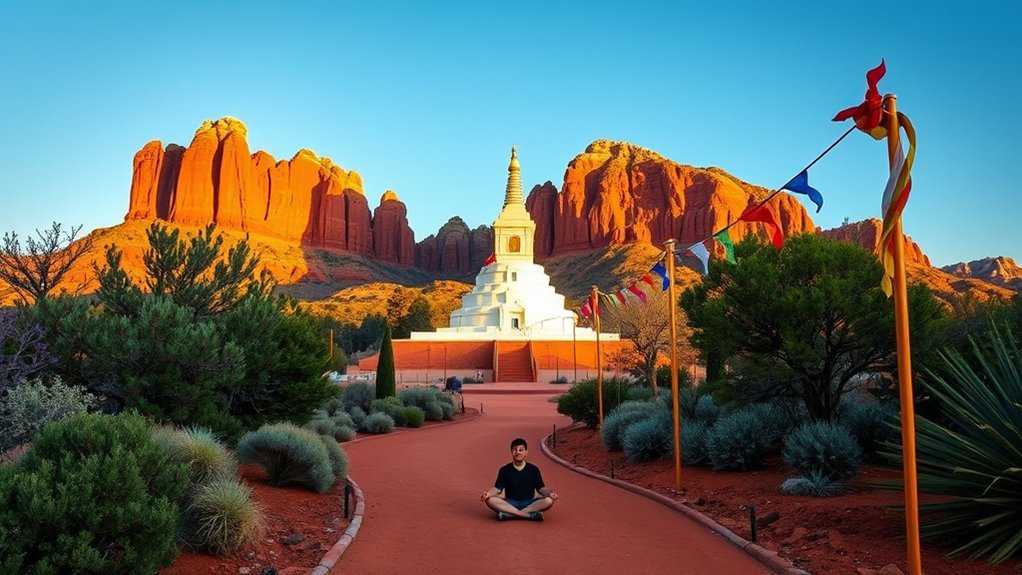
When you walk into Amitabha Stupa & Peace Park, you’ll feel the quiet power of a structure built to symbolize compassion and healing. Learn the stupa’s history and meaning as you follow gentle park trails that loop through junipers and red rock views. Bring a few moments for seated meditation at shaded spots to absorb the serenity and reflect.
Stupa History & Meaning
Because stupas have been built across Asia for millennia, visiting the Amitabha Stupa & Peace Park invites you into a living tradition of sacred architecture that both marks and protects the Buddha’s teachings. You’ll sense how form encodes meaning: the dome symbolizes the womb of enlightenment, the spire points to awakening, and relic chambers honor teachers. As you approach, note the stupa’s geometric harmony and the careful placement of prayer wheels and offerings.
- Learn: stupa elements map the path from suffering to liberation.
- Reflect: materials and proportions convey impermanence and refuge.
- Respect: stupas function as reliquaries, commemorations, and focal points for devotion.
This history grounds your visit in reverence and insight.
Park Trails & Meditation
Though the stupa sits at the heart of the park, the trails themselves invite you into a quieter, walking meditation—soft dirt paths wind through juniper and sage, rising to rocky viewpoints where you can pause, breathe, and listen. You’ll find benches, cairns, and open ledges that encourage presence; hikers move respectfully, often in silence, absorbing the red-rock light. Early morning and late afternoon give you the best temperatures and colors. Bring water, wear sturdy shoes, and follow leave-no-trace principles so the place stays intact for others.
| Feature | Tip |
|---|---|
| Trail length | Choose short loops for reflection |
| Terrain | Expect rocks and gentle climbs |
| Best time | Sunrise or late afternoon |
| Etiquette | Keep voices low, pack out trash |
Enjoy Wine Tasting in Verde Valley
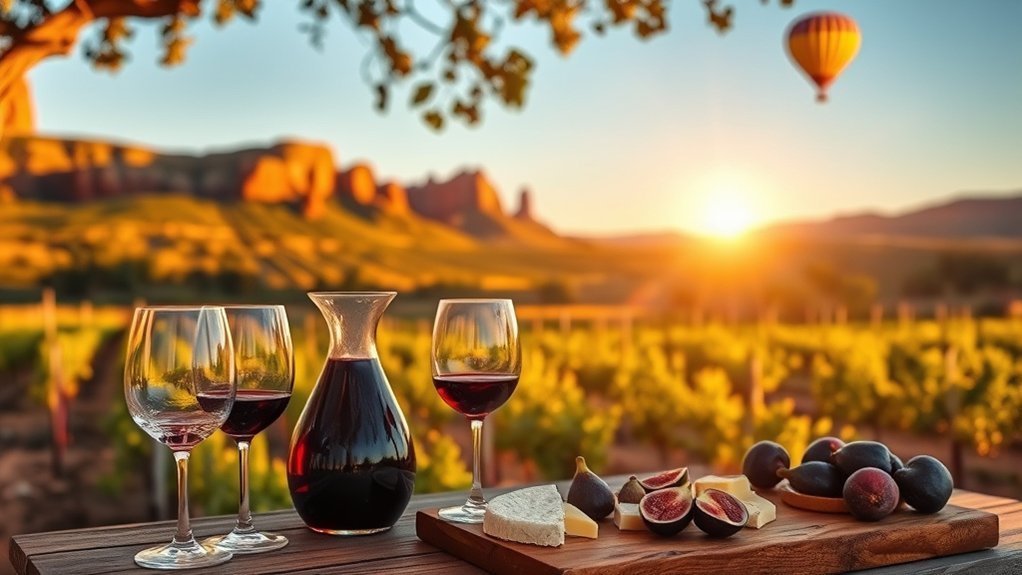
Venture into Verde Valley and you’ll find a surprising oasis of boutique wineries framed by red-rock vistas and open desert skies. You can sample small-production reds and whites made from high-desert grapes while guides explain local terroir, winemaking choices, and tasting notes that connect flavor to landscape. Plan a relaxed afternoon and you’ll leave with bottles, stories, and a clearer sense of Arizona wine.
Venture into Verde Valley’s boutique wineries—red‑rock views, high‑desert grapes, and stories in every glass.
- Choose a tasting room with outdoor seating so you can sip against the scenery; ask about flights that showcase signature varietals.
- Book a guided tasting or vineyard tour to learn how elevation and climate shape the wines; expect candid, expert conversation.
- Pace yourself: taste, cleanse your palate, and pick up a map of nearby wineries to create a self-guided loop for the day.
You’ll enjoy approachable hosts, thoughtfully produced wines, and the calm of Verde Valley — authentic, friendly, and easy to explore.
Take a Hot Air Balloon Ride
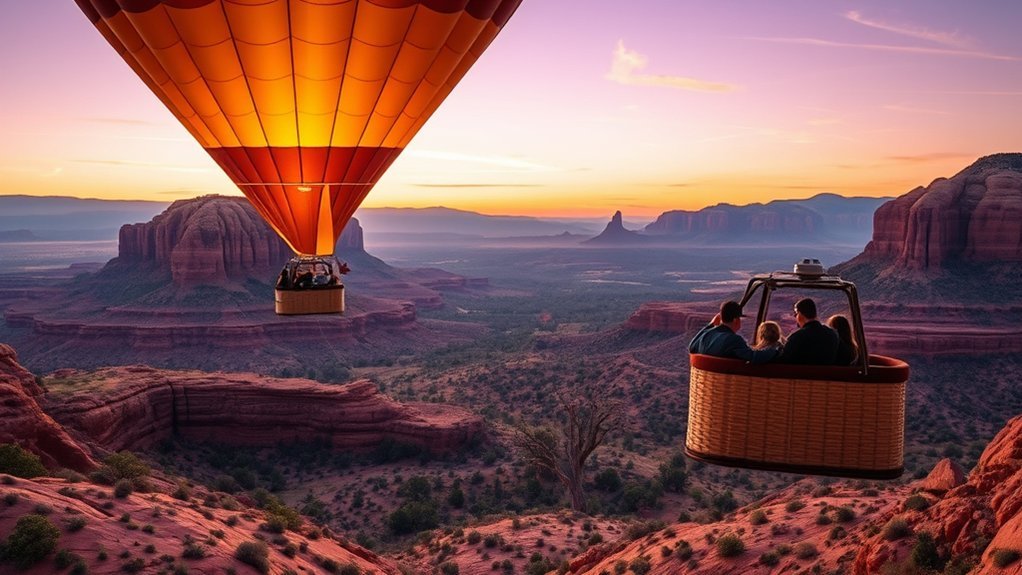
From a gently rising basket you’ll watch sunrise paint Sedona’s red rocks and desert washes in golds and crimsons, a quiet perspective few get to see. You’ll feel the air cool and still, then warm as burners roar and the landscape unfurls beneath you. Pilots point out landmarks—Chapel of the Holy Cross, Cathedral Rock silhouettes—and explain wind patterns and flight path choices so you understand why each ride is unique.
Flights typically last an hour with preflight safety briefings and gentle landings; operators provide experienced pilots, radios, and backup crews. Dress in layers, wear closed shoes, and bring a camera with a secure strap. Morning flights avoid thermal turbulence and give the best light; sunset options exist but vary by company. Expect a short drive to launch sites outside town and a celebratory postflight toast. Booking in advance is wise, especially in high season—this is one experience you won’t want to miss.
Hike Fay Canyon Trail
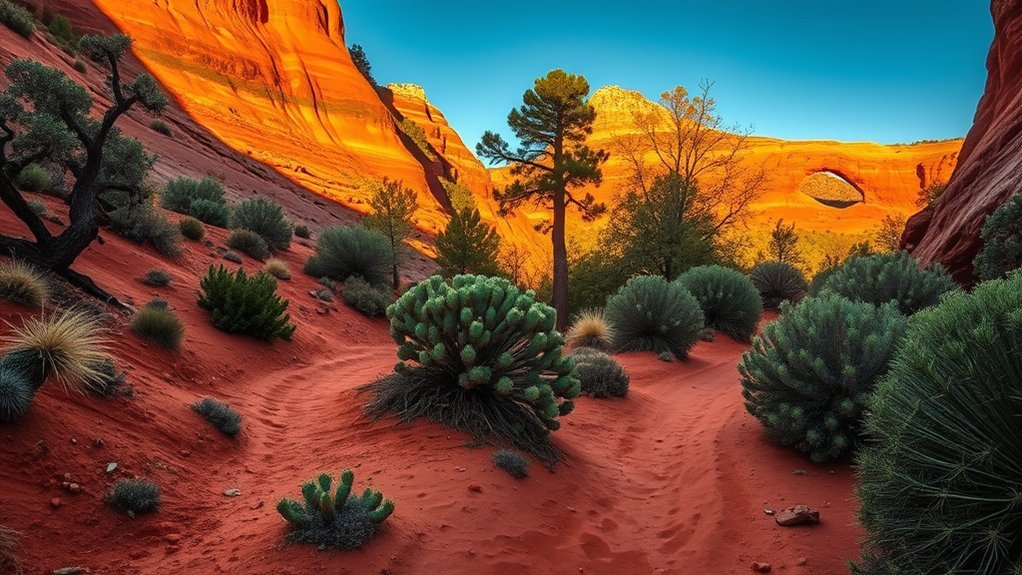
After landing back on solid ground, head to Fay Canyon for a gentle hike that shows Sedona’s red rocks up close without steep scrambling. You’ll follow a shaded wash framed by soaring sandstone walls, noticing hoodoos, native plants, and occasional bird song. The trail’s modest grade and clear path make it ideal when you want scenery without a strenuous climb.
- Plan: arrive early to avoid heat and secure parking; bring water, sun protection, and sturdy shoes.
- Observe: look for petroglyph-like patterns, cactus blooms, and the natural arch tucked near the canyon’s end—respect fragile features.
- Navigate: follow cairns and the main wash; turn back before the unmarked cliffs if you’re not comfortable with light boulder-hopping.
This outing feels intimate and restorative; you’ll leave with a better sense of Sedona’s geology and a quiet appreciation for its quieter canyon experience.
Go Mountain Biking on Bell Rock
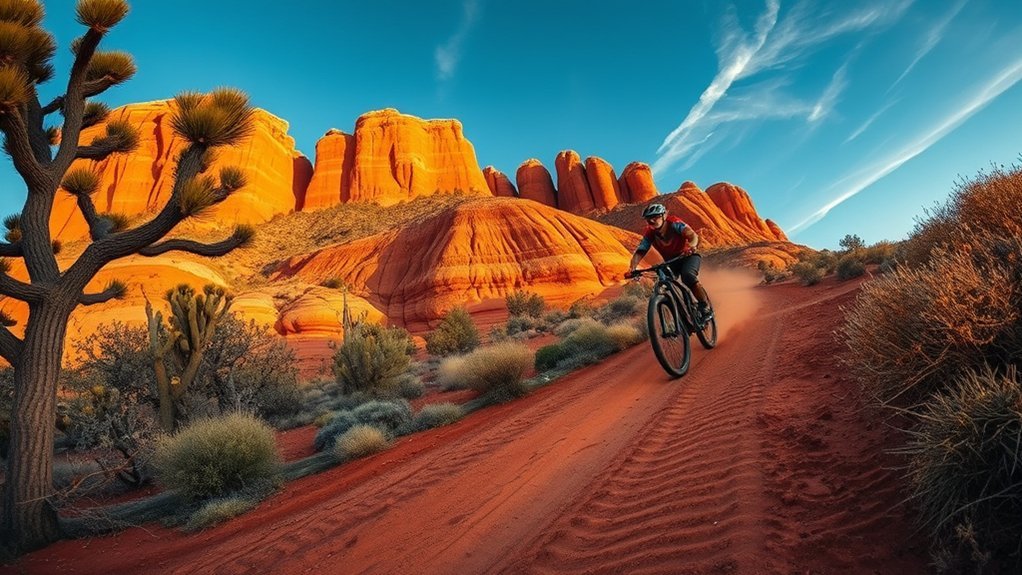
Hop on your bike and tackle Bell Rock’s network of trails, which range from gentle singletrack for beginners to technical climbs and slickrock sections for experienced riders. Check trail ratings before you go and bring a helmet, spare tube, plenty of water, and gloves to handle the rocky, sometimes exposed terrain. Ride with a partner when possible, know your limits on steep descents, and respect seasonal conditions that can make corroded trails slippery or washouts more hazardous.
Trail Difficulty & Options
Though the main Bell Rock Trail is short and forgiving, the surrounding singletrack and connector routes offer everything from easy cruiser lines to steep, technical climbs that’ll challenge experienced riders. You’ll find options that match your skill and mood, with scenic ridgelines, slickrock slabs, and tight switchbacks. Choose a route that fits your fitness and time—loops let you sample varied terrain without committing to a long out-and-back.
- Beginner: smooth, wide trails with gentle grades and frequent viewpoints for easy pacing.
- Intermediate: mixed surfaces, short rock features, and climbs that test balance and momentum.
- Advanced: exposed ridgelines, technical drop-offs, and sustained climbs demanding precise bike handling.
Pick wisely, respect trail etiquette, and savor the red-rock views between efforts.
Safety & Gear Tips
Often you’ll find that good preparation makes the ride as enjoyable as the scenery — on Bell Rock that means the right helmet, gloves, and shoes, plus a bike tuned for rocky, sandy terrain. Bring a compact pump, spare tube, multi-tool, and chain quick-link; flat tires and stripped bolts happen fast on sharp sandstone. Wear layered, moisture-wicking clothing and eye protection to block dust and glare. Carry at least two liters of water and a salty snack—heat and elevation drain you quicker than you expect. Ride with a partner when possible, tell someone your route, and keep your phone charged with offline maps. Respect trail etiquette: yield to hikers, control your speed, and avoid wet sandstone to protect the rock and your tires.
Explore Schnebly Hill Road
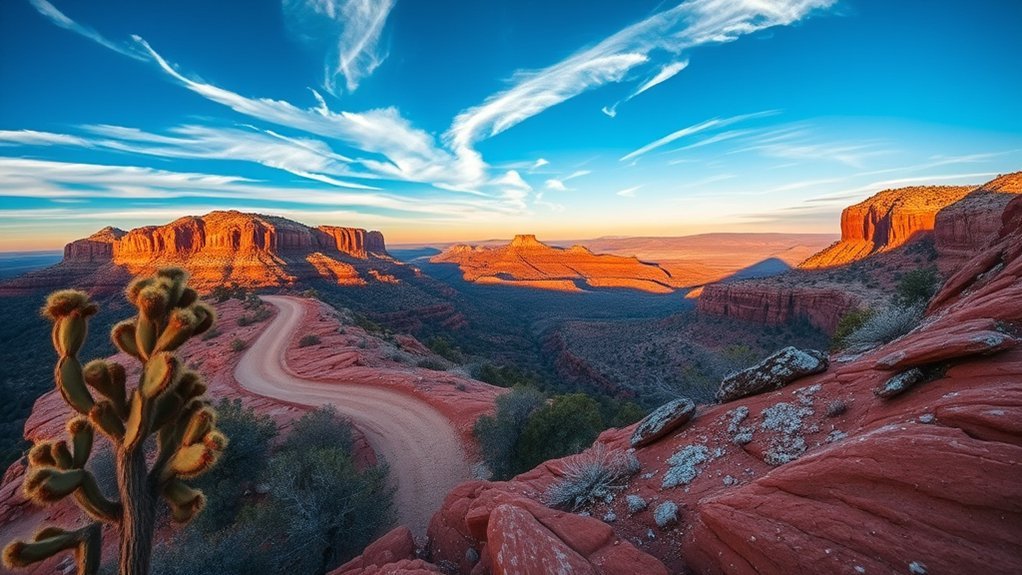
If you drive a high-clearance vehicle or join a guided 4×4 tour, Schnebly Hill Road turns Sedona’s red-rock scenery into an off-road adventure that feels both wild and accessible. You’ll climb rough switchbacks, crest ridgelines with sweeping views of Cathedral Rock and the Verde Valley, and feel the desert wind sharpen each vista. The trail’s raw geology and sparse junipers make photography and quiet reflection rewarding — bring layers for changing sun and wind.
- Plan: check road conditions, fuel, and tire pressure before you go.
- Pace: drive slowly on rocky stretches; use low gear and avoid sudden braking.
- Respect: stay on established tracks and pack out all trash to protect fragile soil.
You’ll leave with an intimate sense of Sedona’s contours and a few favorite overlooks that feel like you discovered them yourself — striking, memorable, and responsibly enjoyed.
Relax at a Sedona Spa
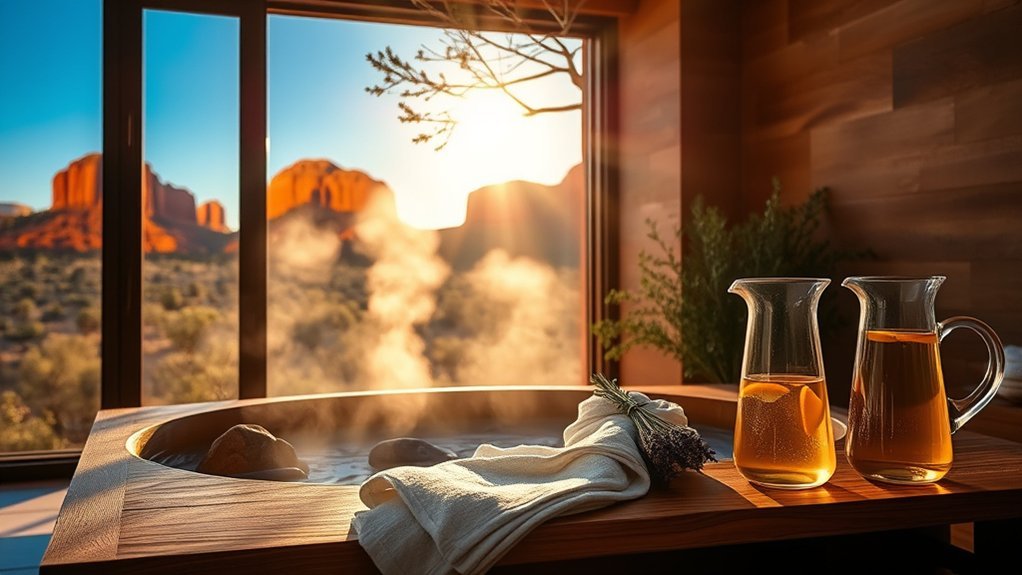
When you need to recharge, Sedona spas offer treatments designed for renewal—think vortex-inspired massages, mineral wraps, and energy-balancing sessions. You’ll find quiet spaces and private relaxation lounges where the red-rock views and soft music help you let go. Ask about signature therapies and secluded spots so you can unwind in comfort and privacy.
Spa Treatments for Renewal
Unwind among red-rock vistas and let Sedona’s spas recalibrate your body and mind with treatments rooted in desert serenity and holistic care. You’ll find signature massages that blend deep tissue, energy work, and indigenous-inspired techniques to release tension and restore balance. Facial and body therapies use local botanicals — prickly pear, sage, and clay — to hydrate and detoxify, leaving skin luminous and calm. Hydrotherapy circuits and salt rooms support circulation and breath, while guided chakra sessions and Reiki help you reconnect internally. Book thoughtfully; many spas offer customizable day packages that combine services for lasting renewal.
- Choose a therapy that targets your top concern (pain, stress, sleep).
- Add a nature-view treatment for grounding.
- Allow post-treatment rest time.
Where to Unwind Quietly
Though Sedona’s red rocks beckon for adventure, you’ll find equal reward in quiet spa rooms where skilled therapists help you slow your breath and soften muscle memory. Choose spas that blend local ingredients—desert clay, juniper, sage—with evidence-based techniques like deep-tissue, lymphatic drainage, or craniosacral therapy. Look for clinics offering private suites, sound-masked relaxation lounges, and windows framing red-rock views so you can shift gently from treatment to stillness. Ask about session length, pressure, contraindications, and whether therapists personalize oil blends or heat elements. Morning treatments let you carry calm into hikes; twilight sessions counteract travel fatigue. Book in advance, arrive early to use steam or infrared lounges, and leave with simple aftercare: hydrate, lean into quiet, and walk slowly back into the light.
Attend a Sedona Art Gallery Opening
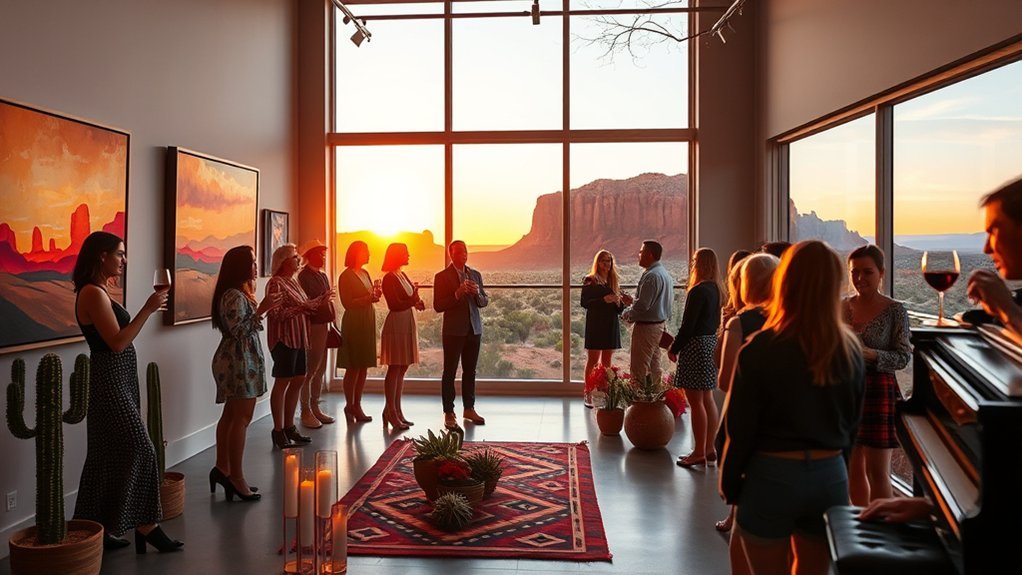
Step into a gallery opening in Sedona and you’ll find the town’s creative pulse on full display — local painters, sculptors, photographers and jewelry makers mingle with visitors beneath warm lighting, red-rock views often visible through gallery windows. You’ll be greeted by artists who’ll talk technique, inspiration and the landscape that shapes their work. Listen for stories about color choices and carving methods, and let pieces that echo Sedona’s light draw you in.
- Arrive early to meet artists, ask about materials and get a guided walk-through.
- Take photos where allowed, note titles and prices, and request provenance or care tips for pieces you love.
- Buy small works or prints to take a memory home, support local creators and start a collection.
You’ll leave with fresh perspectives, a tangible connection to place, and a meaningful souvenir that captures Sedona’s artistic spirit.
Stargaze at Crescent Moon Ranch
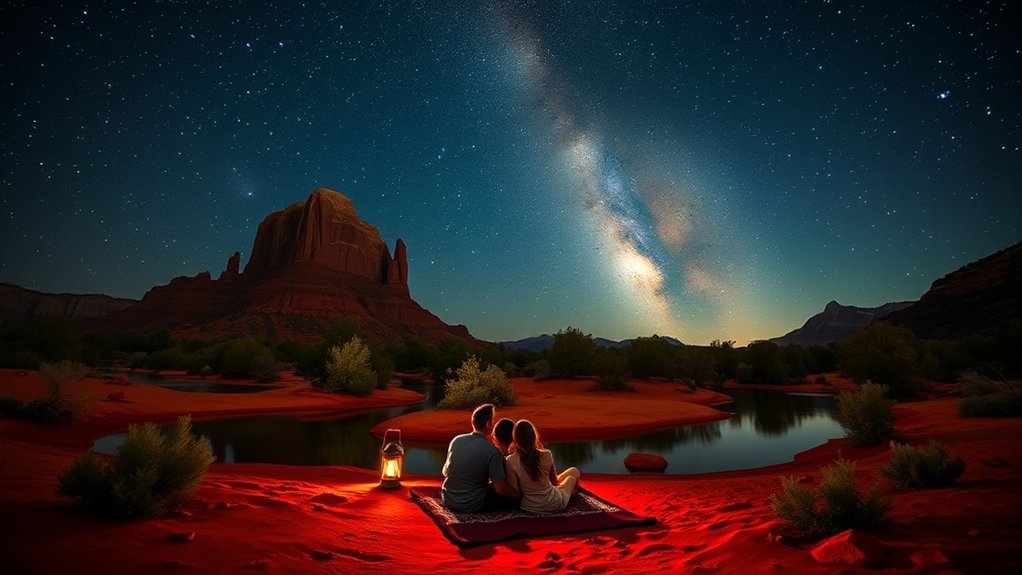
After leaving the warm glow of a gallery, head to Crescent Moon Ranch as night falls and watch the sky become the next exhibit. You’ll find wide-open views of red-rock silhouettes against an ink-blue dome punctured by constellations. Bring a blanket, binoculars, or a small telescope; the ranch’s low light pollution makes Milky Way bands and planets pop. Rangers sometimes offer guided programs—check schedules—and park maps show best vantage points and restroom locations. Stay mindful of trails and private property; preserve darkness by using red-filtered flashlights and keeping voices low.
| What to bring | Why it helps |
|---|---|
| Blanket or chair | Comfortable, lets you stay longer |
| Binoculars/telescope | Reveals surface detail on moon, planets |
You’ll leave feeling small in the best way: connected to the cosmos and Sedona’s landscape, guided by clear paths and simple respect for the night.
Frequently Asked Questions
Are Dogs Allowed on Sedona Hiking Trails and Parks?
Yes — you can bring dogs on many Sedona trails and parks, but you’ll need to keep them leashed, follow posted rules, clean up waste, and avoid sensitive areas; check specific trail regulations before you head out.
What Is the Best Time of Year to Avoid Crowds?
Aim for late fall and winter — you’ll find quieter trails like a soft hush after a storm. You’ll avoid summer crowds, enjoy mild days, fewer tourists, clearer skies, and better parking for exploring red-rock scenery.
Where Can I Refill Water or Find Restrooms in Town?
You can refill water and find restrooms at city parks, visitor centers, grocery stores (Safeway, Fry’s), gas stations, and trailheads like Bell Rock and Cathedral. Carry a reusable bottle; facilities can close seasonally.
Are There Accessible Options for Visitors With Mobility Issues?
Yes — you’ll find accessible trails, scenic drives, adaptive tours, and ADA-compliant facilities; bring mobility aids, call operators ahead for specifics, and try paved viewpoints like Airport Mesa or accessible shuttle services for smoother, confident exploration.
Do I Need Permits for Drone Photography in Sedona?
Yes — you’ll need permits: a city permit for flying in Sedona, a federal registration for your drone, and possibly special BLM or park permits. Follow local rules, respect no-fly zones, and get insurance if you can.
Conclusion
You’ve tasted Sedona’s sun‑washed serenity and spirited sandstone scenery—hike, hum, heal, and heed the hush of hutting red horizons. Wander winding washes, watch wildflower whispers, and soak in secret spiritual spots; each trail, turn and terrace teaches simple truth. Trust your feet, follow fading light, and leave landscapes lovelier than you found them. Return rested, recharged, and ready to relive those radiant, rugged moments beneath a starlit sky.

